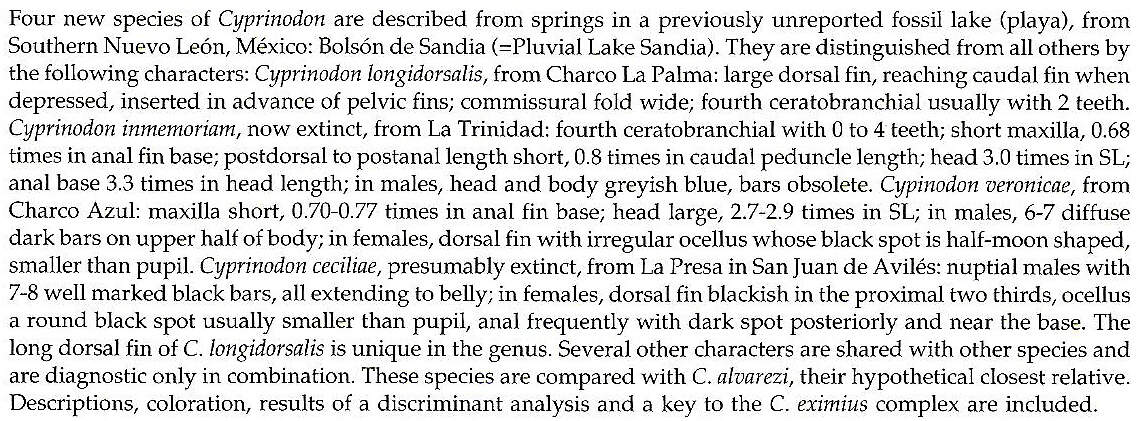KINGSTON, D. I. (1978)
Skiffia francesae, a New Species of Goodeid Fish from Western Mexico.
Copeia 1978 (3): 503–508. doi:10.2307/1443618. JSTOR 1443618.
Abstract:
A new species of Skiffia from the Río Teuchitlán on the Pacific slope of western México is based on both preserved and live material. It is regarded as most closely related to Skiffia multipunctata, as determined by meristic and morphometric data. It differs in shape and form of head and lips, size of orbit and head, diploid number of chromosomes and male coloration.
kingston-biblio
ALLEN, G. & RANDALL, J. (2002)
A review of the leucogaster species complex of the Indo-Pacific pomacentrid genus Amblyglyphidodon, with descriptions of two new species.
aqua, J. Ichthyol. Aquat. Biol. 5(4):139-152.
Zusammenfassung:
Bisher wurde angenommen, dass der indo-pazifische Pomacentride Amblyglyphidodon leucogaster aus verschiedenen, geografischen Farbvarianten bestesteht. Die vorliegende Untersuchung deutet jedoch auf einen aus vier Arten bestehenden Komplex hin: A. leucogaster (Bleeker) aus dem westlichen Pazifik und ostlichen Randgebiet des indischen Ozeans; A. orbicularis (Hombron u. Jacquinot) von Samoa, Fiji und Neu Kaledonien und zwei hier neu beschriebene Arten - A. indicus vom Roten Meer und Indischenr Ozean und A. melanopterus von Tonga. Die einzelnen Arten des leucogaster-Komplexes unterscheiden sich hautsachlich durch Kombinationen von Farbmustern und Anzahl der Kiemenreusen. Ein Bestimmungsschlussel fur Amblyglyphidodon-Arten liegt bei.
allen-biblio
LOZANO VILANO, M. & CONTRERAS BANDERAS, S. (1993)
Four new species of Cyprinodon from southern Nuevo León, Mexico, with a key to the C. eximius complex (Teleostei: Cyprinodontidae).
Ichthyological Explorations of Freshwaters, 4(4):295-308.
Abstract:

lozano-biblio
MILLER, R. R. (1976)
Four New Pupfishes of the Genus Cyprinodon from Mexico, with a Key to the C. eximius Complex.
Bull. Southern California Academy of Sciences 75(2): 68-75.
Volltext: http://www.nativefishlab.net/library/textpdf/15362.pdf
Abstract:
The pupfishes (genus Cyprinodon) referable to the C. eximius complex comprise seven species that are restricted to, or had their origin in, the Chihuahuan Desert region of Mexico and adjacent parts of Texas and New Mexico. Four are described as new; the remainder are C. eximius, C. atrorus, and C. latifasciatus. Most are of restricted distribution; one is extinct and another may be. Keys, diagnoses, and ranges are given for each species and all are illustrated. The distinctive morphometric characters of the new species are given. Life colors and color patterns are important in distinguishing species
miller-biblio
MARIAUX, J. & TILBURY, C. R. (2006)
The pygmy chameleons of the eastern Arc range (Tanzania): Evolutionary relationships and the description of three new species of Rhampholeon (Sauria: Chamaeleonidae).
Herpetological Journal 16 (3): 315-331.
Volltext
Abstract:
The pygmy chameleons of the Eastern Arc Range forests in Tanzania are reviewed on the basis of known and newly collected material. Two new species be longing to Rhampholeon (Rhinodigitum) and one to Rh. (Rhampholeon) from the Pare, Nguru and Mahenge Mountains are described. The status and distribution of the other species known in the area are reviewed, and an identification key is provided. The phylogenetic relationships between these taxa are discussed on the basis of small and large mt-rDNA subunits sequences and the relative importance of some morphological characters is evaluated. Hypotheses about the evolution of the group in the area are presented.
mariaux-biblio
mariaux-biblio
POSSO-TERRANOVA, A. & ANDRÉS, J. (2018)
Multivariate species boundaries and conservation of harlequin poison frogs.
Molecular Ecology 27 (17): 3432-3451.
Abstract:
In this study, we present an iterative method for delimiting species under the general lineage concept (GLC) based on the multivariate clustering of morphological, ecological and genetic data. Our rationale is that distinct multivariate groups correspond to evolutionarily independent metapopulation lineages because they reflect the common signal of different secondary defining properties (environmental and genetic distinctiveness, phenotypic diagnosability, etc.) that imply the existence of barriers preventing or limiting gene exchange. We applied this method to study a group of endangered poison frogs, the Oophaga histrionica complex. In our study case, we used next-generation targeted amplicon sequencing to obtain a robust genetic data set that we combined with patterns of morphological and ecological features. Our analyses revealed the existence of at least five different species in the histrionica complex (three, new to science), some of them, occurring in small isolated populations outside any protected areas. The lineage delimitation proposed here has important conservation implications as it revealed that some of the Oophaga species should be considered among the most vulnerable of the Neotropical frogs. More broadly, our study exemplifies how multiple-amplicon and multivariate statistical techniques can be integrated to successfully identify species and their boundaries.
posso-biblio
LARROUSSE, F. (1924)
Description de la femelle de Triatoma maxima (Uhler, 1894).
Ann. Parasitol. Hum. Comp., 1924, 2 : n° 3, 207–210.
https://doi.org/10.1051/parasite/1924023207
Zusammenfassung:
Dans cette courte note, nous décrivons la femelle de Triatoma maxima (Uhler, 1894). Ce Triatoma, qui est la plus grande espèce actuellement connue, est caractérisé par sa couleur noire brillante ; son connexivum très épais, bordé de rouge et par des touffes de poils couleur ocre à l'apex des tibias et sur les tarses.
larrousse-biblio
PERGER, R. & WALL, A. (2014)
The description of a new species of the Neotropical land crab genus Gecarcinus Leach, 1814 (Crustacea, Decapoda, Brachyura, Gecarcinidae).
Zookeys. 2014; (435): 93–109. Published online 2014 Aug 18. doi: 10.3897/zookeys.435.7271
Abstract:
In this contribution a new species of the land crab genus Gecarcinus Leach, 1814, from the Neotropical Pacific coast of South America is described and illustrated. In addition to its unique body color, Gecarcinus nobilii sp. n. is distinguished from congeners by a distinctly wider carapace front and differences in the shape of the infraorbital margin. The new species is not isolated from Gecarcinus populations from the Pacific coast of Central America by an insurmountable geographic barrier. Considering the closure of the Panamanian Isthmus as a calibration point for morphological divergence between the trans-isthmian mainland populations of Gecarcinus, the virtual lack of morphological differentiation (other than color) between them and the distinctness of G. nobilii sp. n. suggests that G. nobilii sp. n. evolved from a common ancestor before the Isthmus closed.
perger-biblio